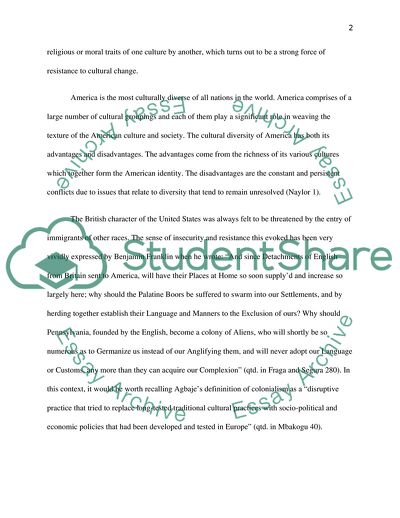
- Home
- Free Samples
- Premium Essays
- Editing Services
- Extra Tools
- Essay Writing Help
- About Us
- Studentshare
- Subjects
- Miscellaneous
- Literature review of at least 10 sources for your paper. This should be in essay form. At the end of the essay have a references cited page where your referen
Literature review of at least 10 sources for your paper. This should be in form. At the end of the have a references cited page where your referen - Essay Example

- Subject: Miscellaneous
- Type: Essay
- Level: Masters
- Pages: 4 (1000 words)
- Downloads: 0
- Author: heathcotemarcel
Extract of sample "Literature review of at least 10 sources for your paper. This should be in form. At the end of the have a references cited page where your referen"
The forces that work against cultural change within a society are habits, tradition and religion. “Habitual behavior provides emotional security in a threatening world of change” (“Processes of Change” par.5). The roles of different individuals in a society or groups of individuals are interdependent on each other. Hence cultural changes in one or more may affect the rest. The processes that work between societies can be broadly categorized as diffusion, acculturation and transculturation (“Processes of Change” par.7). Diffusion occurs when traits move from one culture to another.
Acculturation is the process where diffusion occurs on a mass scale to replace traditional patterns with new alien ones. The result is culture loss for the natives of the region. Such acculturation can be seen among the American Indians who are now forced to look at themselves and at the world “from a European perspective” (“Processes of Change” par.9). Transculturation happens when an individual moves to another culture and adapts to their ways. In the event of not adapting to their ways, he or she may become socially isolated.
Yet another process, that is, stimulus diffusion occurs when one aspect of one culture generates a spark that leads to an invention in another culture. Ethnocentrism leads to rejection of the religious or moral traits of one culture by another, which turns out to be a strong force of resistance to cultural change. America is the most culturally diverse of all nations in the world. America comprises of a large number of cultural groupings and each of them play a significant role in weaving the texture of the American culture and society.
The cultural diversity of America has both its advantages and disadvantages. The advantages come from the richness of its various cultures which together form the American identity. The disadvantages are the constant and persistent conflicts due to issues that relate to diversity that tend to
...Download file to see next pages Read More
- TERMS & CONDITIONS
- PRIVACY POLICY
- COOKIES POLICY